Research on How Blockchain Technology Eliminates Blood Diamonds
VerifiedAdded on 2023/06/05
|5
|1140
|492
Report
AI Summary
This research paper investigates the potential of blockchain technology to eliminate blood diamonds from the diamond industry. It highlights the issues within the current Kimberly Process Certification Scheme (KPCS) and how blockchain, with its tamper-proof ledger, can provide a solution. The paper analyzes literature discussing initiatives like Everledger, which uses blockchain to create digital fingerprints for diamonds, enhancing traceability and security. The research methodology relies on secondary sources, including scholarly articles and industry reports. The discussion section emphasizes the potential of blockchain to increase security and prevent blood diamonds from entering the market. The report concludes by recommending the adoption of blockchain technology across the diamond industry to address loopholes in the existing system, such as fake certificates and security concerns. Desklib provides this and many other solved assignments for students.
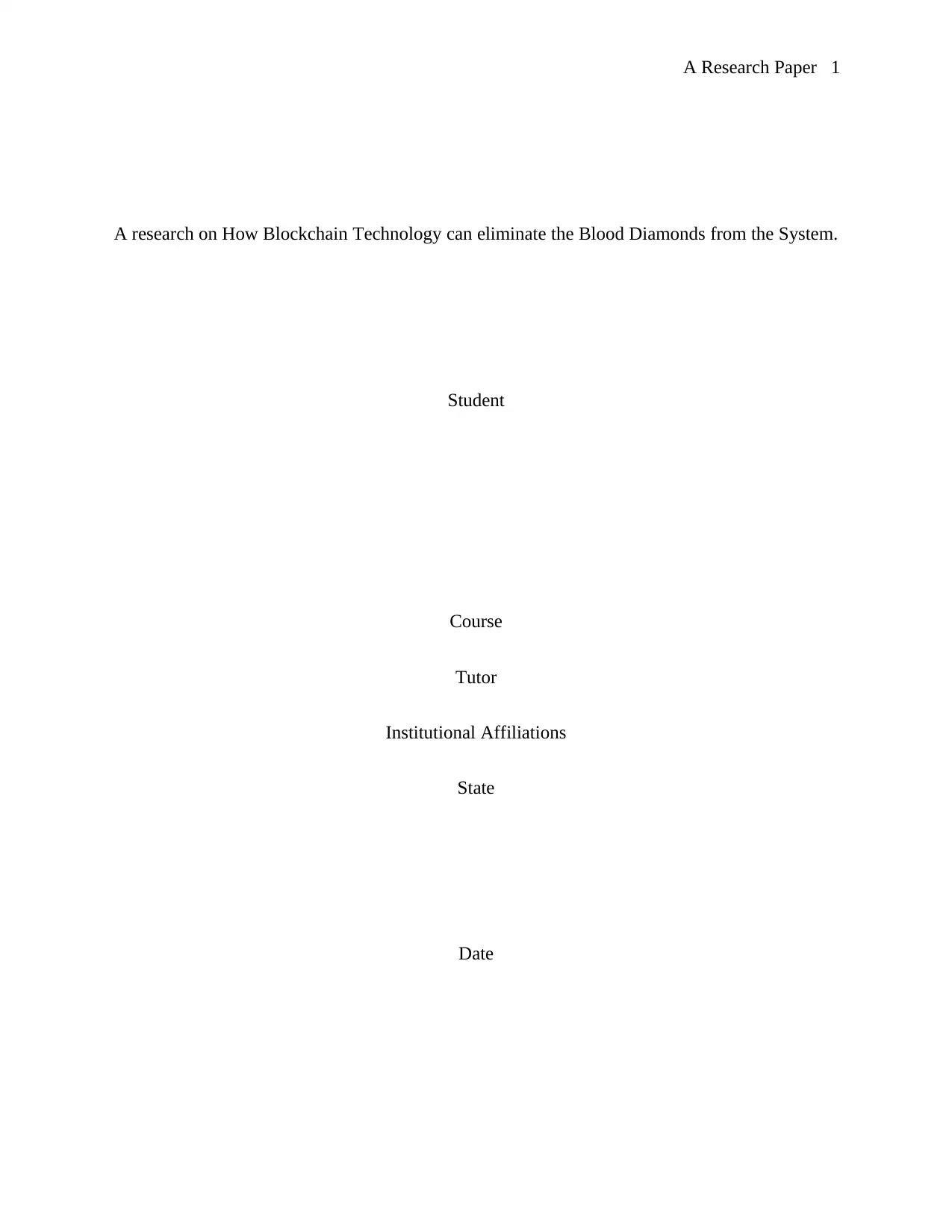
A Research Paper 1
A research on How Blockchain Technology can eliminate the Blood Diamonds from the System.
Student
Course
Tutor
Institutional Affiliations
State
Date
A research on How Blockchain Technology can eliminate the Blood Diamonds from the System.
Student
Course
Tutor
Institutional Affiliations
State
Date
Paraphrase This Document
Need a fresh take? Get an instant paraphrase of this document with our AI Paraphraser
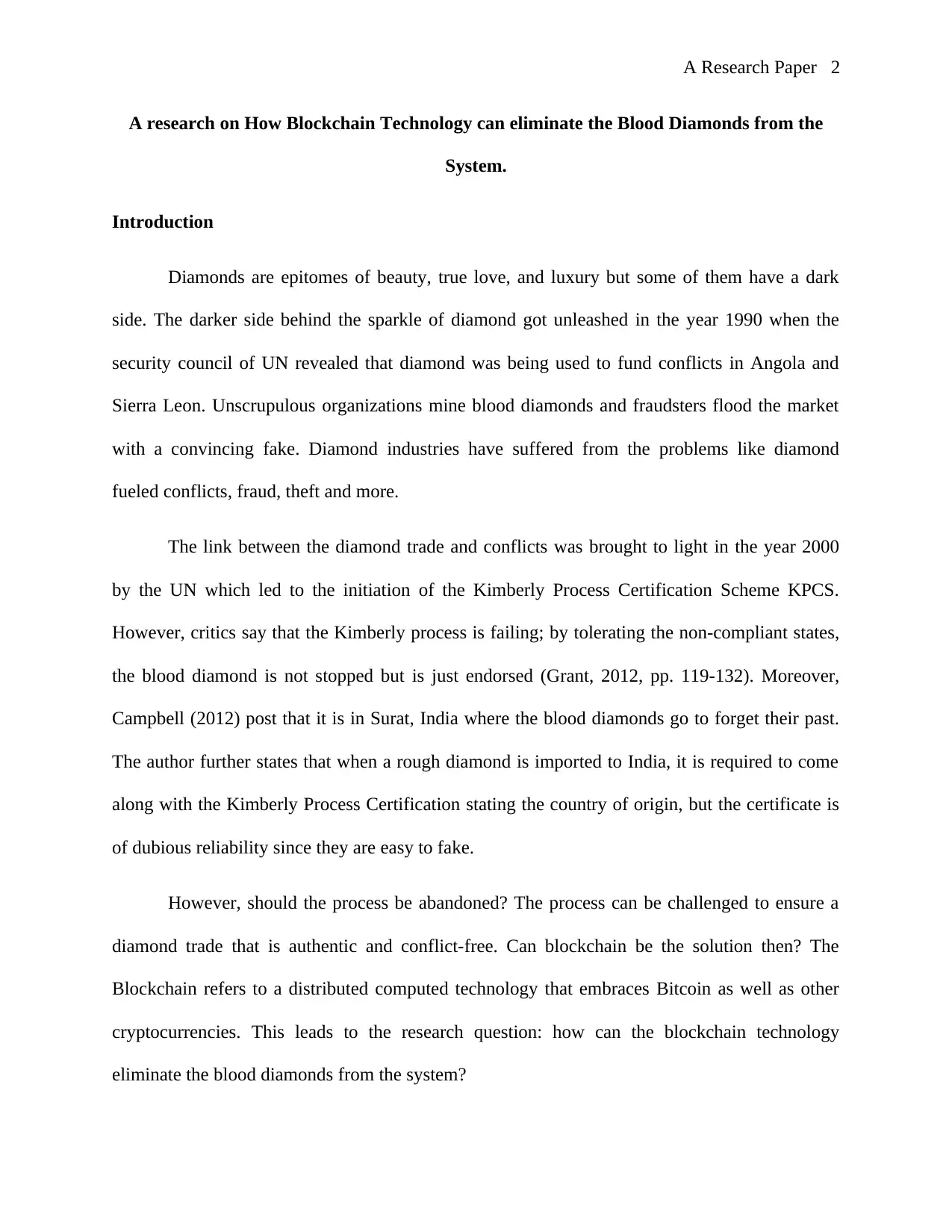
A Research Paper 2
A research on How Blockchain Technology can eliminate the Blood Diamonds from the
System.
Introduction
Diamonds are epitomes of beauty, true love, and luxury but some of them have a dark
side. The darker side behind the sparkle of diamond got unleashed in the year 1990 when the
security council of UN revealed that diamond was being used to fund conflicts in Angola and
Sierra Leon. Unscrupulous organizations mine blood diamonds and fraudsters flood the market
with a convincing fake. Diamond industries have suffered from the problems like diamond
fueled conflicts, fraud, theft and more.
The link between the diamond trade and conflicts was brought to light in the year 2000
by the UN which led to the initiation of the Kimberly Process Certification Scheme KPCS.
However, critics say that the Kimberly process is failing; by tolerating the non-compliant states,
the blood diamond is not stopped but is just endorsed (Grant, 2012, pp. 119-132). Moreover,
Campbell (2012) post that it is in Surat, India where the blood diamonds go to forget their past.
The author further states that when a rough diamond is imported to India, it is required to come
along with the Kimberly Process Certification stating the country of origin, but the certificate is
of dubious reliability since they are easy to fake.
However, should the process be abandoned? The process can be challenged to ensure a
diamond trade that is authentic and conflict-free. Can blockchain be the solution then? The
Blockchain refers to a distributed computed technology that embraces Bitcoin as well as other
cryptocurrencies. This leads to the research question: how can the blockchain technology
eliminate the blood diamonds from the system?
A research on How Blockchain Technology can eliminate the Blood Diamonds from the
System.
Introduction
Diamonds are epitomes of beauty, true love, and luxury but some of them have a dark
side. The darker side behind the sparkle of diamond got unleashed in the year 1990 when the
security council of UN revealed that diamond was being used to fund conflicts in Angola and
Sierra Leon. Unscrupulous organizations mine blood diamonds and fraudsters flood the market
with a convincing fake. Diamond industries have suffered from the problems like diamond
fueled conflicts, fraud, theft and more.
The link between the diamond trade and conflicts was brought to light in the year 2000
by the UN which led to the initiation of the Kimberly Process Certification Scheme KPCS.
However, critics say that the Kimberly process is failing; by tolerating the non-compliant states,
the blood diamond is not stopped but is just endorsed (Grant, 2012, pp. 119-132). Moreover,
Campbell (2012) post that it is in Surat, India where the blood diamonds go to forget their past.
The author further states that when a rough diamond is imported to India, it is required to come
along with the Kimberly Process Certification stating the country of origin, but the certificate is
of dubious reliability since they are easy to fake.
However, should the process be abandoned? The process can be challenged to ensure a
diamond trade that is authentic and conflict-free. Can blockchain be the solution then? The
Blockchain refers to a distributed computed technology that embraces Bitcoin as well as other
cryptocurrencies. This leads to the research question: how can the blockchain technology
eliminate the blood diamonds from the system?
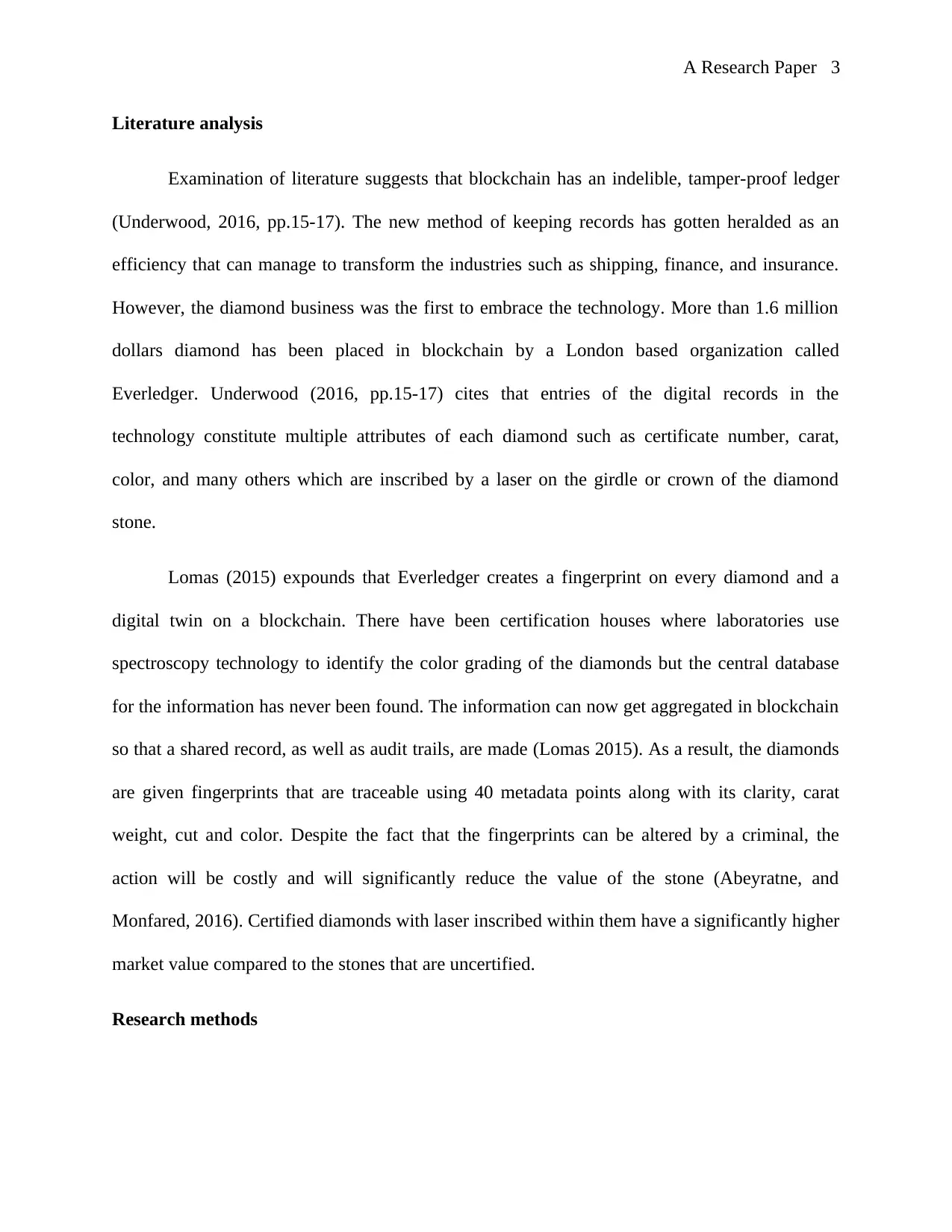
A Research Paper 3
Literature analysis
Examination of literature suggests that blockchain has an indelible, tamper-proof ledger
(Underwood, 2016, pp.15-17). The new method of keeping records has gotten heralded as an
efficiency that can manage to transform the industries such as shipping, finance, and insurance.
However, the diamond business was the first to embrace the technology. More than 1.6 million
dollars diamond has been placed in blockchain by a London based organization called
Everledger. Underwood (2016, pp.15-17) cites that entries of the digital records in the
technology constitute multiple attributes of each diamond such as certificate number, carat,
color, and many others which are inscribed by a laser on the girdle or crown of the diamond
stone.
Lomas (2015) expounds that Everledger creates a fingerprint on every diamond and a
digital twin on a blockchain. There have been certification houses where laboratories use
spectroscopy technology to identify the color grading of the diamonds but the central database
for the information has never been found. The information can now get aggregated in blockchain
so that a shared record, as well as audit trails, are made (Lomas 2015). As a result, the diamonds
are given fingerprints that are traceable using 40 metadata points along with its clarity, carat
weight, cut and color. Despite the fact that the fingerprints can be altered by a criminal, the
action will be costly and will significantly reduce the value of the stone (Abeyratne, and
Monfared, 2016). Certified diamonds with laser inscribed within them have a significantly higher
market value compared to the stones that are uncertified.
Research methods
Literature analysis
Examination of literature suggests that blockchain has an indelible, tamper-proof ledger
(Underwood, 2016, pp.15-17). The new method of keeping records has gotten heralded as an
efficiency that can manage to transform the industries such as shipping, finance, and insurance.
However, the diamond business was the first to embrace the technology. More than 1.6 million
dollars diamond has been placed in blockchain by a London based organization called
Everledger. Underwood (2016, pp.15-17) cites that entries of the digital records in the
technology constitute multiple attributes of each diamond such as certificate number, carat,
color, and many others which are inscribed by a laser on the girdle or crown of the diamond
stone.
Lomas (2015) expounds that Everledger creates a fingerprint on every diamond and a
digital twin on a blockchain. There have been certification houses where laboratories use
spectroscopy technology to identify the color grading of the diamonds but the central database
for the information has never been found. The information can now get aggregated in blockchain
so that a shared record, as well as audit trails, are made (Lomas 2015). As a result, the diamonds
are given fingerprints that are traceable using 40 metadata points along with its clarity, carat
weight, cut and color. Despite the fact that the fingerprints can be altered by a criminal, the
action will be costly and will significantly reduce the value of the stone (Abeyratne, and
Monfared, 2016). Certified diamonds with laser inscribed within them have a significantly higher
market value compared to the stones that are uncertified.
Research methods
⊘ This is a preview!⊘
Do you want full access?
Subscribe today to unlock all pages.

Trusted by 1+ million students worldwide
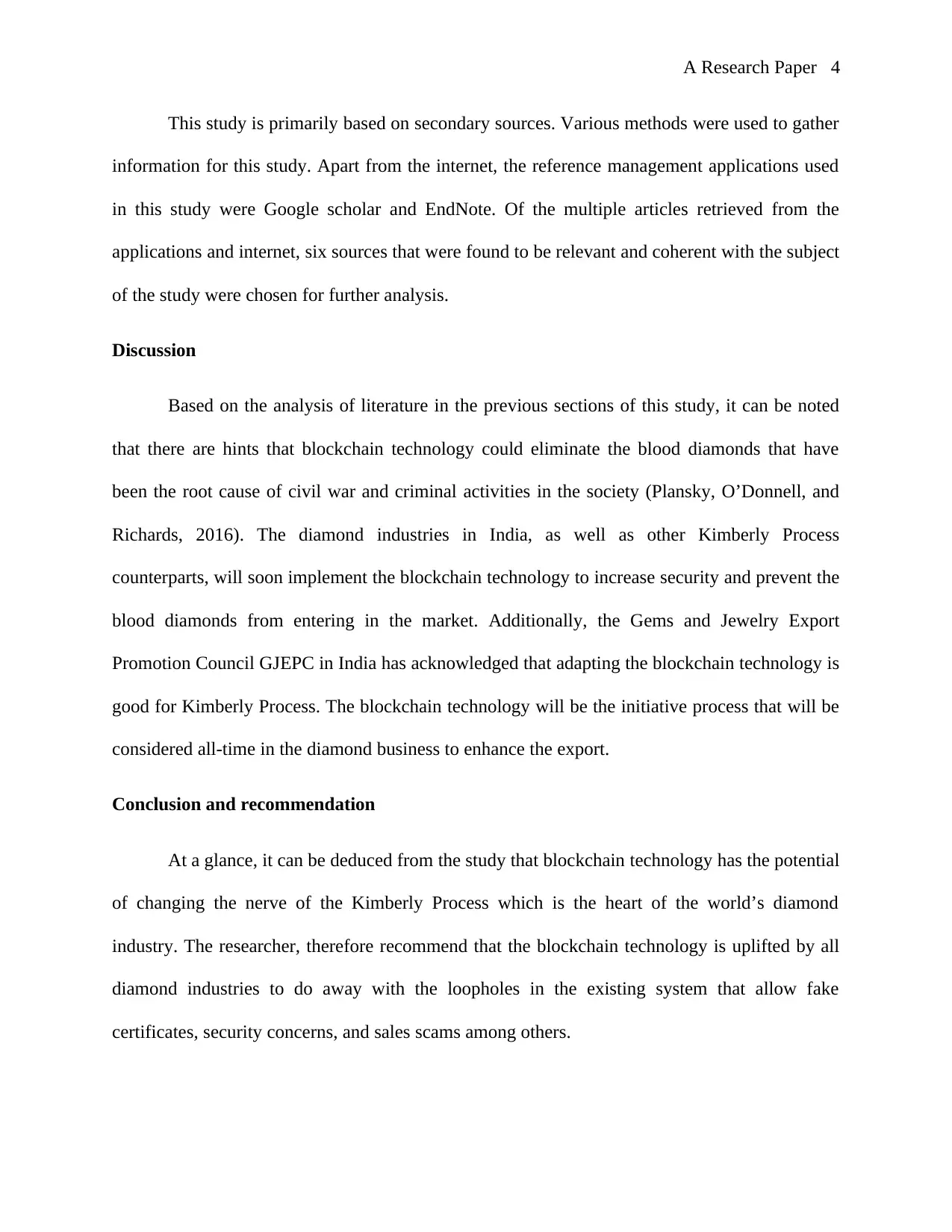
A Research Paper 4
This study is primarily based on secondary sources. Various methods were used to gather
information for this study. Apart from the internet, the reference management applications used
in this study were Google scholar and EndNote. Of the multiple articles retrieved from the
applications and internet, six sources that were found to be relevant and coherent with the subject
of the study were chosen for further analysis.
Discussion
Based on the analysis of literature in the previous sections of this study, it can be noted
that there are hints that blockchain technology could eliminate the blood diamonds that have
been the root cause of civil war and criminal activities in the society (Plansky, O’Donnell, and
Richards, 2016). The diamond industries in India, as well as other Kimberly Process
counterparts, will soon implement the blockchain technology to increase security and prevent the
blood diamonds from entering in the market. Additionally, the Gems and Jewelry Export
Promotion Council GJEPC in India has acknowledged that adapting the blockchain technology is
good for Kimberly Process. The blockchain technology will be the initiative process that will be
considered all-time in the diamond business to enhance the export.
Conclusion and recommendation
At a glance, it can be deduced from the study that blockchain technology has the potential
of changing the nerve of the Kimberly Process which is the heart of the world’s diamond
industry. The researcher, therefore recommend that the blockchain technology is uplifted by all
diamond industries to do away with the loopholes in the existing system that allow fake
certificates, security concerns, and sales scams among others.
This study is primarily based on secondary sources. Various methods were used to gather
information for this study. Apart from the internet, the reference management applications used
in this study were Google scholar and EndNote. Of the multiple articles retrieved from the
applications and internet, six sources that were found to be relevant and coherent with the subject
of the study were chosen for further analysis.
Discussion
Based on the analysis of literature in the previous sections of this study, it can be noted
that there are hints that blockchain technology could eliminate the blood diamonds that have
been the root cause of civil war and criminal activities in the society (Plansky, O’Donnell, and
Richards, 2016). The diamond industries in India, as well as other Kimberly Process
counterparts, will soon implement the blockchain technology to increase security and prevent the
blood diamonds from entering in the market. Additionally, the Gems and Jewelry Export
Promotion Council GJEPC in India has acknowledged that adapting the blockchain technology is
good for Kimberly Process. The blockchain technology will be the initiative process that will be
considered all-time in the diamond business to enhance the export.
Conclusion and recommendation
At a glance, it can be deduced from the study that blockchain technology has the potential
of changing the nerve of the Kimberly Process which is the heart of the world’s diamond
industry. The researcher, therefore recommend that the blockchain technology is uplifted by all
diamond industries to do away with the loopholes in the existing system that allow fake
certificates, security concerns, and sales scams among others.
Paraphrase This Document
Need a fresh take? Get an instant paraphrase of this document with our AI Paraphraser
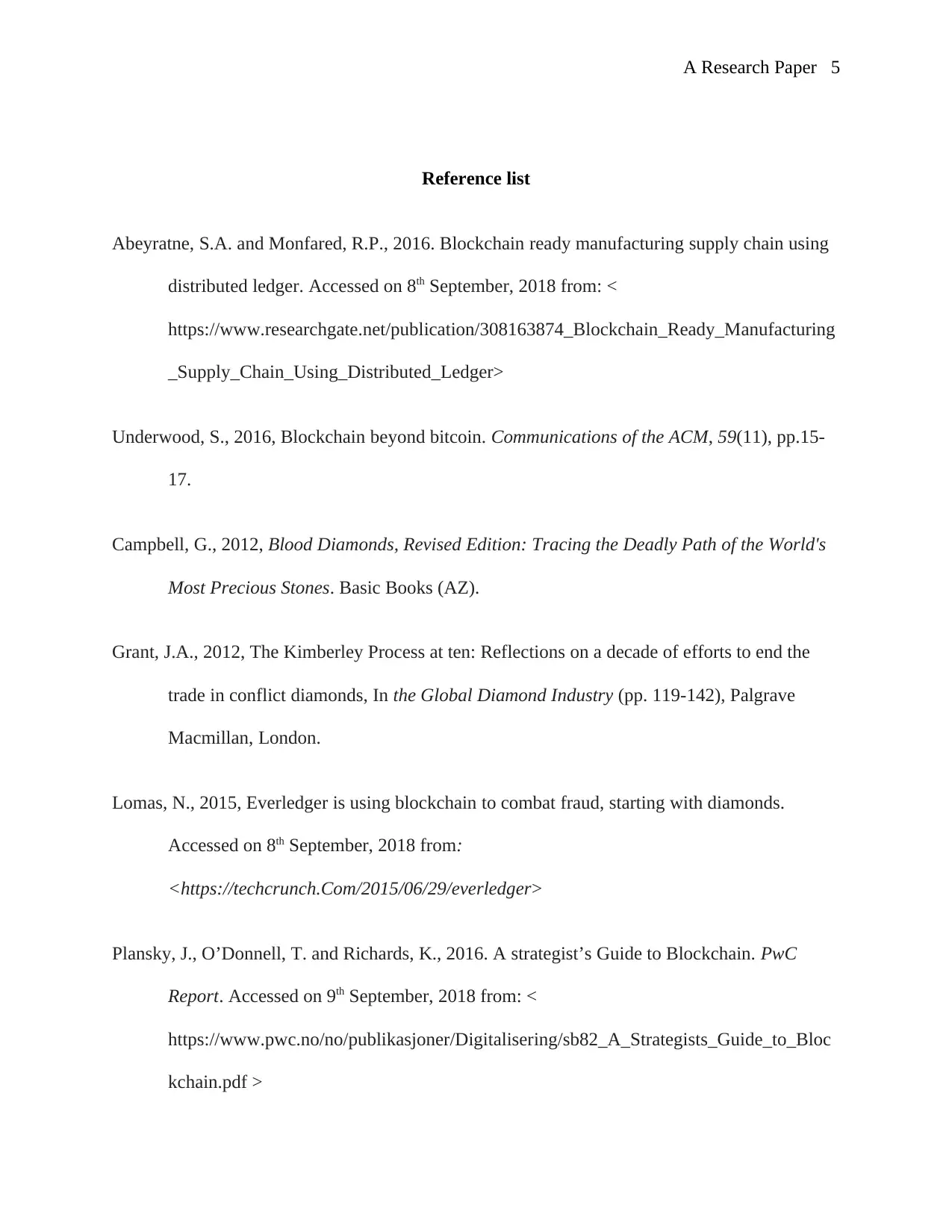
A Research Paper 5
Reference list
Abeyratne, S.A. and Monfared, R.P., 2016. Blockchain ready manufacturing supply chain using
distributed ledger. Accessed on 8th September, 2018 from: <
https://www.researchgate.net/publication/308163874_Blockchain_Ready_Manufacturing
_Supply_Chain_Using_Distributed_Ledger>
Underwood, S., 2016, Blockchain beyond bitcoin. Communications of the ACM, 59(11), pp.15-
17.
Campbell, G., 2012, Blood Diamonds, Revised Edition: Tracing the Deadly Path of the World's
Most Precious Stones. Basic Books (AZ).
Grant, J.A., 2012, The Kimberley Process at ten: Reflections on a decade of efforts to end the
trade in conflict diamonds, In the Global Diamond Industry (pp. 119-142), Palgrave
Macmillan, London.
Lomas, N., 2015, Everledger is using blockchain to combat fraud, starting with diamonds.
Accessed on 8th September, 2018 from:
<https://techcrunch.Com/2015/06/29/everledger>
Plansky, J., O’Donnell, T. and Richards, K., 2016. A strategist’s Guide to Blockchain. PwC
Report. Accessed on 9th September, 2018 from: <
https://www.pwc.no/no/publikasjoner/Digitalisering/sb82_A_Strategists_Guide_to_Bloc
kchain.pdf >
Reference list
Abeyratne, S.A. and Monfared, R.P., 2016. Blockchain ready manufacturing supply chain using
distributed ledger. Accessed on 8th September, 2018 from: <
https://www.researchgate.net/publication/308163874_Blockchain_Ready_Manufacturing
_Supply_Chain_Using_Distributed_Ledger>
Underwood, S., 2016, Blockchain beyond bitcoin. Communications of the ACM, 59(11), pp.15-
17.
Campbell, G., 2012, Blood Diamonds, Revised Edition: Tracing the Deadly Path of the World's
Most Precious Stones. Basic Books (AZ).
Grant, J.A., 2012, The Kimberley Process at ten: Reflections on a decade of efforts to end the
trade in conflict diamonds, In the Global Diamond Industry (pp. 119-142), Palgrave
Macmillan, London.
Lomas, N., 2015, Everledger is using blockchain to combat fraud, starting with diamonds.
Accessed on 8th September, 2018 from:
<https://techcrunch.Com/2015/06/29/everledger>
Plansky, J., O’Donnell, T. and Richards, K., 2016. A strategist’s Guide to Blockchain. PwC
Report. Accessed on 9th September, 2018 from: <
https://www.pwc.no/no/publikasjoner/Digitalisering/sb82_A_Strategists_Guide_to_Bloc
kchain.pdf >
1 out of 5
Your All-in-One AI-Powered Toolkit for Academic Success.
+13062052269
info@desklib.com
Available 24*7 on WhatsApp / Email
![[object Object]](/_next/static/media/star-bottom.7253800d.svg)
Unlock your academic potential
Copyright © 2020–2025 A2Z Services. All Rights Reserved. Developed and managed by ZUCOL.